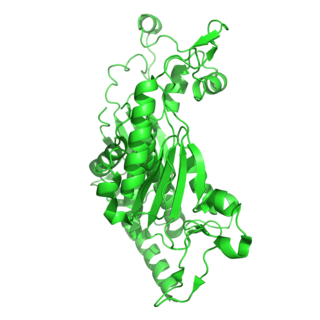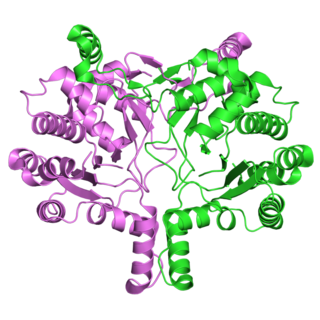Mycolic acids are long fatty acids found in the cell walls of Mycobacteriales taxon, a group of bacteria that includes Mycobacterium tuberculosis, the causative agent of the disease tuberculosis. They form the major component of the cell wall of many Mycobacteriales species. Despite their name, mycolic acids have no biological link to fungi; the name arises from the filamentous appearance their presence gives Mycobacteriales under high magnification. The presence of mycolic acids in the cell wall also gives Mycobacteriales a distinct gross morphological trait known as "cording". Mycolic acids were first isolated by Stodola et al. in 1938 from an extract of M. tuberculosis.

Isocitrate lyase, or ICL, is an enzyme in the glyoxylate cycle that catalyzes the cleavage of isocitrate to succinate and glyoxylate. Together with malate synthase, it bypasses the two decarboxylation steps of the tricarboxylic acid cycle and is used by bacteria, fungi, and plants.

The enzyme chorismate synthase catalyzes the chemical reaction
In enzymology, a 2-isopropylmalate synthase (EC 2.3.3.13) is an enzyme that catalyzes the chemical reaction

In enzymology, a β-ketoacyl-[acyl-carrier-protein] synthase III (EC 2.3.1.180) is an enzyme that catalyzes the chemical reaction

In enzymology, a malate synthase (EC 2.3.3.9) is an enzyme that catalyzes the chemical reaction
In enzymology, a Z-farnesyl diphosphate synthase is an enzyme that catalyzes the chemical reaction
In enzymology, an alpha,alpha-trehalose-phosphate synthase (UDP-forming) is an enzyme that catalyzes the chemical reaction

In enzymology, an ATP phosphoribosyltransferase is an enzyme that catalyzes the chemical reaction

In enzymology, a 2-C-methyl-D-erythritol 4-phosphate cytidylyltransferase is an enzyme that catalyzes the chemical reaction:

In molecular biology, YgbB is a protein domain. This entry makes reference to a number of proteins from eukaryotes and prokaryotes which share this common N-terminal signature and appear to be involved in terpenoid biosynthesis. The YgbB protein is a putative enzyme thought to aid terpenoid and isoprenoid biosynthesis, a vital chemical in all living organisms. This protein domain is part of an enzyme which catalyses a reaction in a complex pathway.
Decaprenyl-phosphate phosphoribosyltransferase is an enzyme with systematic name trans,octacis-decaprenylphospho-beta-D-ribofuranose 5-phosphate:diphosphate phospho-alpha-D-ribosyltransferase. This enzyme catalyses the following chemical reaction
Trans,polycis-decaprenyl diphosphate synthase is an enzyme with systematic name (2Z,6E)-farnesyl-diphosphate:isopentenyl-diphosphate farnesylcistransferase . This enzyme catalyses the following chemical reaction
Ditrans,polycis-polyprenyl diphosphate synthase is an enzyme with systematic name (2E,6E)-farnesyl-diphosphate:isopentenyl-diphosphate cistransferase . This enzyme catalyses the following chemical reaction

Tuberculosinol synthase (EC 3.1.7.8, Rv3378c) is an enzyme with systematic name tuberculosinyl diphosphate diphosphohydrolase (tuberculosinol forming). This enzyme catalyses the following chemical reaction
Phyllocladan-16α-ol synthase (EC 4.2.3.45, PaDC1) is an enzyme with systematic name (+)-copalyl-diphosphate diphosphate-lyase (phyllocladan-16α-ol-forming). This enzyme catalyses the following chemical reaction
(+)-β-Caryophyllene synthase is an enzyme with systematic name (2Z,6E)-farnesyl-diphosphate diphosphate-lyase . This enzyme catalyses the following chemical reaction:
Tetraprenyl-β-curcumene synthase is an enzyme with systematic name all-trans-heptaprenyl-diphosphate diphosphate-lyase . This enzyme catalyses the following chemical reaction
Halimadienyl-diphosphate synthase is an enzyme with systematic name halima-5,13-dien-15-yl-diphosphate lyase (decyclizing). This enzyme catalyses the following chemical reaction
Isotuberculosinol, also called nosyberkol or edaxadiene is a diterpene molecule produced by the bacterium Mycobacterium tuberculosis, the causative agent of TB, which aids in its pathogenesis. Isotuberculosinol functions by preventing maturation of the host-cell phagosome in which the bacterium lives. Maturation of the phagosome would enable it to kill the bacterium. Mutations in genes involved in the biosynthetic pathway of nosyberkol result in normal development of the phagosome and reduction of mycobacterial infection. These biosynthetic genes include isotuberculosinol synthase.








